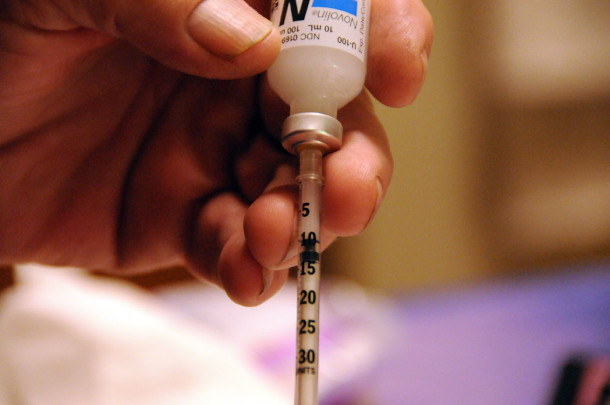Chemicals and the Obesity Epidemic
Air Date: Week of December 3, 2021

Phthalates get into our food through packaging and food handling equipment like paper, cellophane and plastic wrapping. (Photo: Marco Verch, Flickr, CC BY 2.0)
With two out of three Americans overweight and a third considered obese, a new meta-study correlates the phthalates in plastics not only with bigger waistlines but also a wide variety of other disorders including male and female reproduction problems and mental health troubles. Phthalates are ubiquitous in the environment, including fast food hamburgers, medical tubing and personal care products. Biologist Maricel Maffini, the lead researcher in this study, joins Host Steve Curwood to discuss the urgent need for authorities better regulate phthalates.
Transcript
BASCOMB: It’s Living on Earth, I’m Bobby Bascomb.
CURWOOD: And I’m Steve Curwood.
It turns out many health dangers of some plastic chemicals have been hidden in plain sight. Phthalates are a group of synthetic compounds often used to make plastics more flexible and they’re found in everything from personal care products to food packaging and even medical tubing. It’s been known for years that phthalates can pose health hazards to male development. And more recently phthalates found in fast foods were linked to deadly forms of heart disease among middle aged people. And now thanks to a new meta study, phthalates are correlated with a wide variety of chronic diseases in every demographic including women and children. Those health hazards include diabetes, obesity, and even mental and behavioral problems. The research team included an American, a biologist at University of Gothenburg in Sweden and three researchers in Switzerland. For more than two years they compiled more than three dozen studies of the health effects of phthalates to reveal this wide array of chronic diseases linked to the chemicals, links that until now have been largely ignored for risk assessment. And the US Food and Drug Administration, still considers phthalates safe in food and cosmetics. The research team was led by PhD biologist and independent consultant Maricel Maffini, who joins us now. Maricel welcome to Living on Earth!
MAFFINI: Thank you very much.
CURWOOD: Your study is a real eye opener. I mean, this compilation of a bunch of studies really points to the fact that metabolic disease, obesity, pancreatic issues might well be involved here. I mean, you consider the two thirds of US adults are considered overweight and one in three US adults is considered to be obese. What does your study or studies suggest about the relationship between these plasticizing chemicals and the fact that so many of us are well, on the heavy side?
MAFFINI: Well, I want to add that in addition to being plasticizers, phthalates are used in many other ways. They are used in inks, in printing inks, in fragrances to carry fragrances longer, in adhesives, so they are really everywhere in our house. So one of the things that we identified was that relationship with increased body weight. And it seems like they are involved in how we regulate our metabolism. So how much can we burn off the nutrients that we need to power our bodies and if we don't burn them all or as much, and they accumulate in the body that's how we get a little a little bit toward the heavy side. So in this case, what we saw is that there is an increase in a body mass index, there's an increase in the circumference of the waist, and phthalates may be related to that, because they increase the accumulation of fat in the adipose tissue, they also reduce the metabolism of the body by for instance, reducing or being associated with the reduction in the levels of thyroid hormones that we produce, in addition to the fact that they also appear to be working against how our muscles use energy and instead of using more of that energy, that energy is accumulated as fat tissue.
CURWOOD: And part of your research points to papers that show a connection between phthalates the insulin resistance in children and men and women. In other words, diabetes or diabetes like conditions that are so prevalent in our society now.

The meta-study of ortho-phthalates found that two of the five chemicals (DIBP and DEHP) were associated with insulin resistance in children, men and women. (Photo: momboleum, Flickr, CC BY-NC-ND 2.0)
MAFFINI: That's correct, and those are two of the measurements or the health effects that we saw that are very, very prevalent as you mentioned. And they are not usually looked at when we studied chemicals in animals. So, we are looking at when we test chemicals in animals, we are really not looking at what is prevalent in the society in the human population. We are looking at the weight of organs, we take organs and put them on a scale, and we measure if they reduce the weight, or they increase their weight. But we are not studying things like are we getting these animals to be diabetic? Are we getting these animals to change their behavior when they are exposed to these chemicals? Do we get them fat? We don't really study much so there are things that we need to do better when it comes to risk assessment of chemicals.
CURWOOD: In fact, not part of your study but recently a group at New York University suggests that exposure to phthalates over a period of time is linked to higher cardiovascular events and mortality.
MAFFINI: That is correct. That was Dr. Trasande from NYU. Yes, he was part of that study.
CURWOOD: And of course, what you're referring to is that the regulations don't consider this, that when United States chemical regulators look at these chemicals, they don't consider the kinds of effects that you're finding but instead, they do this in animals, and I gather they focus a lot on male reproduction?
MAFFINI: That is correct because phthalates, mostly because of one of them that is called DEHP is a well-known chemical that interfere with the male hormones. And they're very known for disrupting the development of the male reproductive system. So, because of that, most of the studies done for many years on phthalates, were about whether or not they cause those problems. And other issues that may be happening were not really looked at. So, the regulators use those animal studies, and they looked at the male reproduction, and based on those effects then they established what is called a safe dose.
CURWOOD: But now how does phthalate exposure affect women and children?
MAFFINI: Well, that was one of the very, it was surprise to us to see how little phthalate exposure is needed to see effects in the ovaries, for example. Women were having fewer eggs in their ovaries and children born to mothers exposed to phthalates, to the higher levels of phthalates, were found to have behavioral problems, problems with learning, lower IQ, or decrease abilities to make decisions, or motor skills with their hands and their movements.
CURWOOD: Now, why can exposure to small doses be more troublesome than large ones? Why would such tiny doses have such a huge impact for women and children?
MAFFINI: That is usually associated with some hormonal effects. So, your natural hormones, your androgens, estrogens, thyroid hormones, insulin, they are incredibly effective information molecules, signaling molecules. So, when you have chemicals that are acting in similar ways or interfering with the function of hormones, you don't need much to see an effect. And some of those effects may look like something that we couldn't pay much attention to. But later in life could be triggered by other exposures, it could become a health problem.
CURWOOD: One of the remarkable findings that you have here also regards to mental illness, mental illnesses is at an all time high in the United States and Europe, at least measured, and it's documented that one in five US adults will live with mental illness. What do we know so far about the connection between phthalates and mental health mental development?

According to the CDC, medical costs related to obesity total more than $140 billion a year in the U.S. (Photo: Marco Verch, Flickr, CC BY-ND-ND 2.0)
MAFFINI: What we know is mostly related to children exposures and mostly children's exposed during development. So when your brain is developing, in general, when any organ is developing, it follows a sequence, it's like when you're writing a symphony, everything has to happen in an orderly way, at a particular time, for a particular duration, for things to your cells to develop, to proliferate, to differentiate into the different parts of the brain, to be located in specific areas of the brain and therefore those cells and connections to happen. So, when things don't go the correct way during brain development you cannot go back and rewire the brain. So, we are seeing issues with children when it comes to behavior, when it comes to learning disabilities, when it comes to delinquency that are associated with phthalates and mostly with the phthalates in the mom. When the mom was exposed depending on the trimester in which she was exposed, which organs were being developed at that particular time, then the children, we can see those effects. But I think again, phthalates are just our way to show the concerns and the problems with the way we do risk assessment and manage chemical exposures because these are just five of the large families of phthalates and of a much larger chemical soup in which we are all living. So, there could be what people call cocktail effects, that then there are other chemicals that are also affecting the brain and I can give you another list of those affecting brain development.
CURWOOD: So how are these chemicals regulated in the European Union compared to the United States?
MAFFINI: In the European Union, there are a few more limitations. And there are specific doses, reference doses or safe doses that some phthalates specifically these five that we'll look at should comply with. In the US, the Food and Drug Administration that regulates chemicals in food, do not have limits on how much phthalates could be in the food supply. So, the Consumer Product Safety Commission, they do have limits on phthalates, for children's toys and for other articles that are used for children uses, like the teethers when kids are teething, there are some soft plastic rings, rubber duckies all those were removed from phthalates. But here's the problem, all the agencies are doing a risk assessment for each particular chemical and these chemicals are all alike and they should be regulated as a class. Because they are similar, you remove one because there's a regulation and you are a new one, they will have the same function and you will be in compliance. So, until we start regulating chemicals that are similar and have similar health effects and they look alike as a class, as a group where we have a safe dose for all of them, not a safe dose for each individual. If we reduce the exposure levels, we will be better off, and it will be more efficient.
CURWOOD: So, I have to say that your, your study is simply shocking. I mean pointing to the relationship between obesity, mental health problems, child development problems, delinquency, diabetes, I mean, the list is so long pointing to this group of chemicals. Why didn't we know?

Maricel Maffini has a PhD in biological sciences from the National University of Litoral in Argentina and worked at Tufts University School of Medicine for more than 11 years; she now works as a scientist and independent consultant. (Photo: Courtesy of Maricel Maffini)
MAFFINI: I think, I think we didn't know because we don't communicate properly. We have and we call this in the paper the bookends, bookends of environmental health. On the one hand, at the beginning of when a chemical is going to get into commerce there are regulators looking at the information that companies provide to show that the chemical use is going to be safe. On the other end you have the healthcare providers, that they see people, they see their struggles, they see their health problems, they see dysfunctions of organs, they see behavioral problems and most of the things do not have a genetic component, as you mentioned at the beginning. So, they start to look at what is in their environment. What is in the house? What do they eat? Do they have lead paint in the houses? Those type of things, and they generate some of the information that then we use in our paper. But the healthcare professionals and the regulators don't talk to each other. So, until we understand that with so much human data should be informing the regulations, very little is going to change. And phthalates is just one group of chemicals that have been in commerce for decades. This is what we use just to make the case, we need to turn the system upside down.
CURWOOD: Maricel Maffini is a biological scientist. Thanks so much for taking time with us today.
MAFFINI: Thank you for having me, it's been a pleasure.
CURWOOD: So, Bobby, Maricel Maffini brought an interesting pedigree to this work.
BASCOMB: Oh, really what’s that?
CURWOOD: For more than a decade she worked with Ana Soto a researcher and investigator at Tufts University Medical School in Boston. Dr. Soto is famous for noting some thirty years ago that breast cancer cells grew faster in plastic tubes, as if the cells were in the presence of estrogen. This was some of the earliest work documenting that some chemicals in plastic can mimic hormones and cause health problems.
BASCOMB: Uncovering so many more diseases linked to phthalates is pretty shocking, Steve! And we know that phthalates are found in everyday products from our TV remote controls and hairbrushes to our food.
CURWOOD: Yeah, and big money is involved here. The US chemical industry has more than $750 billion in sales every year and it’s closely linked to fossil fuels, which are the feedstocks for most plastics. But the CDC says chronic health costs for just heart disease, diabetes, and obesity in the US add up to close to $650 billion each year. That doesn’t include the health care costs of many other associated diseases and you can’t put a price on human misery. Of course, removing phthalates from our everyday products would require major regulation and I think it’s safe to assume that would bring push back from industry.
BOBBY: I’m sure. Well, let’s hope studies like these spark much better regulation of phthalates and other environmental health risks.
Links
Read the study: “Role of epidemiology in risk assessment: a case study of five ortho-phthalates”
Check out the Living on Earth story on phthalates and cardiovascular disease
Living on Earth wants to hear from you!
Living on Earth
62 Calef Highway, Suite 212
Lee, NH 03861
Telephone: 617-287-4121
E-mail: comments@loe.org
Newsletter [Click here]
Donate to Living on Earth!
Living on Earth is an independent media program and relies entirely on contributions from listeners and institutions supporting public service. Please donate now to preserve an independent environmental voice.
NewsletterLiving on Earth offers a weekly delivery of the show's rundown to your mailbox. Sign up for our newsletter today!
 Sailors For The Sea: Be the change you want to sea.
Sailors For The Sea: Be the change you want to sea.
 The Grantham Foundation for the Protection of the Environment: Committed to protecting and improving the health of the global environment.
The Grantham Foundation for the Protection of the Environment: Committed to protecting and improving the health of the global environment.
 Contribute to Living on Earth and receive, as our gift to you, an archival print of one of Mark Seth Lender's extraordinary wildlife photographs. Follow the link to see Mark's current collection of photographs.
Contribute to Living on Earth and receive, as our gift to you, an archival print of one of Mark Seth Lender's extraordinary wildlife photographs. Follow the link to see Mark's current collection of photographs.
 Buy a signed copy of Mark Seth Lender's book Smeagull the Seagull & support Living on Earth
Buy a signed copy of Mark Seth Lender's book Smeagull the Seagull & support Living on Earth

